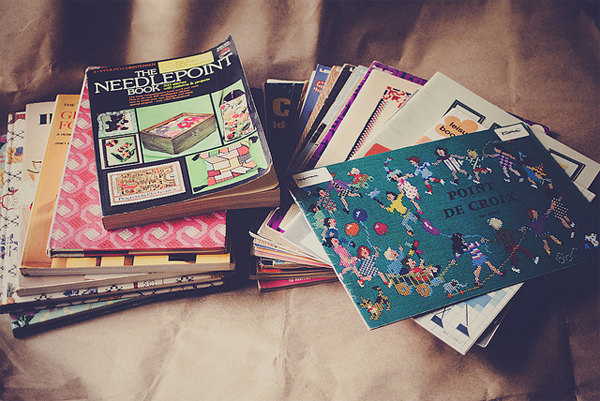I like to shop at thrift stores. Scratch that. I love to shop at thrift stores! One of my favorite sections of any thrift store (and they all have this section) is the books. My kids love to read, as do I, but the reason I adore the books section is the abundance of old craft books. I cannot get enough of old pattern leaflets, books and home decor magazines from decades past. They are just a treasure trove of knitting inspiration!

Often times, I come across a beautiful pattern. More specifically, a beautiful stitch pattern. Unfortunately, I sometimes find them in garments I have zero interest in making. If you find yourself in this situation, do what I do: understand it, then adapt it to work in something you actually want to make.
Swatch it out!
A lot of the vintage patterns I come across do not put the stitch pattern out in front of the whole pattern to reference. If that’s the case, you will have to read through and find the pattern repeat. Once you do, swatch it out in the yarn you want to work with. This will help you figure out your gauge for that particular stitch pattern in the particular yarn you want to use.
Use your gauge to determine how many stitches you will need to cast on for your project.
Spin it around!
If you want to knit something in the round, you will have to change the pattern a bit. Let’s say there is a piece of a sweater pattern you fall in love with, but it is knit flat in pieces. Fortunately for us, a lot of patterns will call for purling across the entire wrong side. This just means you have to knit every other row. Huzzah! Easy.
Unfortunately, some really gorgeous patterns call for more complicated wrong sides. If this is the case, do not panic! We just need to work out a few things. Repeat after me: this is going to be FUN!
You cannot just switch all purl stitches to knit. You also have to work it backwards. Here is a simple example (not taken from any pattern in particular, just some stitches used to illustrate how to reverse a wrong side to work from the right side; garter stitch is a great example!):
Flat:
Row 1: (K 1, yo, k2tog) twice, K 6
Row 2: K 6, (P 1, yo, p2tog) twice
Adapted for working in the round:
Round 1: (K 1, yo, k2tog) twice, K 6 [stays the same]
Round 2: (k2tog, yo, K 1) twice, P 6
Notice the pattern for Round 2 is reversed AND stitches are interchanged; the wrong side of p2tog is k2tog, so they are switched.
Some patterns will be more difficult to adapt. I suggest using your gauge swatch to visually figure the pattern out instead of translating it in writing.
Draw it out!
If you are familiar with using knitting charts, you can use some graph paper and chart it out.
Here is how I would chart out the example stitch pattern:

When working flat patterns from charts, you work Row 1 from right to left, then Row 2 from left to right. If you are working the same pattern in the round, you work ALL rounds from right to left.
Please note that symbols for particular patterns may vary. I did not use the left-slanting decrease (ssk) but I wanted to illustrate how there are two different symbols for the two different decreases. Use what you feel comfortable with, but if you plan to share your pattern, provide a key with the definitions of symbols used. See the Craft Yarn Council list of knit chart symbols for more information.
Make something! And a note on copyright.
I hope these tips help you better understand what you knit. Go out there and get inspired to make something you love! Check out old books or knit garments at the thrift store.
I am a firm believer in adapting patterns to fit your needs, but do not take advantage of an artist’s work by selling wares or even customized patterns with their copyrighted work. Also, make sure to ask permission if you want to share any patterns.
I took that simple garter stitch and lace stitch pattern and made a beret!

Share tips, start a discussion or ask one of our experts or other students a question.
No Responses to “Customized Knitting: Understanding & Adapting Stitch Patterns”